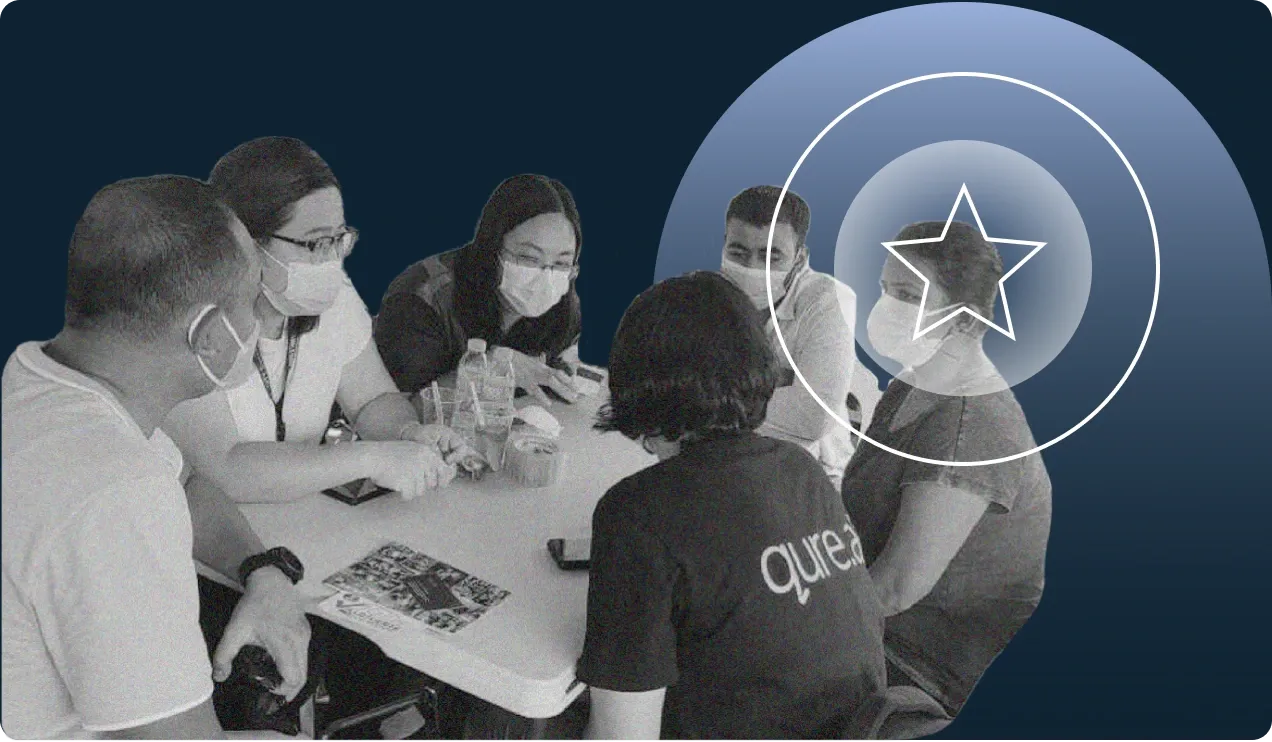World’s
Most Adopted
Healthcare AI











“As part of the EDISON Alliance’s 1 Billion Lives Challenge, AstraZeneca, along with Qure.ai, will be screening 5 million patients by 2025. We look forward to deepening collaboration to accelerate scalable and affordable digital solutions to help improve access to healthcare and transform patient outcomes, especially in underserved communities.”
Leif Johannsson
Chairman at AstraZeneca
“We are thrilled to collaborate with Qure.ai to support surgeons in diagnosing and treating stroke by enabling quicker decision-making, streamlining data sharing between two hospitals, and improving efficiencies so that more stroke patients in India can be treated within the critical time window."
Michael Blackwell
President and Managing Director at Medtronic India
“AI has the potential to power the early diagnosis of lung cancer, TB or Stroke giving the best chance of survival outcomes and improving quality of life for patients. Initial real-world studies and recent FDA clearances have provided compelling evidence for the potential of Qure.ai’s medical imaging AI innovations.”
David M. Rubin
Managing Director at Merck Global Health Innovation Fund LLC
”Qure’s AI technology fits in all kinds of machines, new or old, making sure that we can use the old hardware and save our resources. By integrating Qure.ai with our existing X-ray systems, we can now screen patients promptly, obtain immediate results, and promptly refer clients for further investigation, ensuring timely management of TB cases.”
Llang Bridget M. Maama-Maime
National TB Programme Manager at Ministry of Health, Lesotho
“AI solutions such as qXR should improve the pathway logistics by flagging abnormalities on chest X-rays as soon as they are undertaken, helping patients progress rapidly to CT scanning.”
Prof. David Baldwin
Respiratory Consultant at Nottingham University Hospitals NHS Trust & Honorary Professor of Medicine at the University of Nottingham
“We definitely need to have a quick movement on children. I think children are always left a bit behind. So, it's so exciting that Qure is really looking into and trying to find a way to include the children in the screening with modern digital platforms.”
Dr. Seraphine Kaminsa
Senior Technical Tuberculosis Advisor at Save The Children US
“Lung cancer detection is a significant challenge for healthcare systems globally, with nearly 50% of patients diagnosed at stage 4, leading to poorer outcomes. By using Qure’s AI solution to enhance the speed and accuracy of chest X-rays performed annually at NHSGGC, we can expedite further imaging and treatment, improving patient care throughout the pathway.”
Prof. David Lowe
Professor of Health Innovation at University of Glasgow
"In strategic partnership with Qure.ai, Medica Group is pioneering the integration of augmented intelligence into healthcare, improving patient outcomes by supporting clinicians with cutting edge tools to enhance diagnostic accuracy."
Andrew Cannon
Chief Executive Officer at Medica Group

“As part of the EDISON Alliance’s 1 Billion Lives Challenge, AstraZeneca, along with Qure.ai, will be screening 5 million patients by 2025. We look forward to deepening collaboration to accelerate scalable and affordable digital solutions to help improve access to healthcare and transform patient outcomes, especially in underserved communities.”
Leif Johannsson
Chairman at AstraZeneca

“We are thrilled to collaborate with Qure.ai to support surgeons in diagnosing and treating stroke by enabling quicker decision-making, streamlining data sharing between two hospitals, and improving efficiencies so that more stroke patients in India can be treated within the critical time window."
Michael Blackwell
President and Managing Director at Medtronic India

“AI has the potential to power the early diagnosis of lung cancer, TB or Stroke giving the best chance of survival outcomes and improving quality of life for patients. Initial real-world studies and recent FDA clearances have provided compelling evidence for the potential of Qure.ai’s medical imaging AI innovations.”
David M. Rubin
Managing Director at Merck Global Health Innovation Fund LLC

”Qure’s AI technology fits in all kinds of machines, new or old, making sure that we can use the old hardware and save our resources. By integrating Qure.ai with our existing X-ray systems, we can now screen patients promptly, obtain immediate results, and promptly refer clients for further investigation, ensuring timely management of TB cases.”
Llang Bridget M. Maama-Maime
National TB Programme Manager at Ministry of Health, Lesotho

“AI solutions such as qXR should improve the pathway logistics by flagging abnormalities on chest X-rays as soon as they are undertaken, helping patients progress rapidly to CT scanning.”
Prof. David Baldwin
Respiratory Consultant at Nottingham University Hospitals NHS Trust & Honorary Professor of Medicine at the University of Nottingham

“We definitely need to have a quick movement on children. I think children are always left a bit behind. So, it's so exciting that Qure is really looking into and trying to find a way to include the children in the screening with modern digital platforms.”
Dr. Seraphine Kaminsa
Senior Technical Tuberculosis Advisor at Save The Children US

“Lung cancer detection is a significant challenge for healthcare systems globally, with nearly 50% of patients diagnosed at stage 4, leading to poorer outcomes. By using Qure’s AI solution to enhance the speed and accuracy of chest X-rays performed annually at NHSGGC, we can expedite further imaging and treatment, improving patient care throughout the pathway.”
Prof. David Lowe
Professor of Health Innovation at University of Glasgow

"In strategic partnership with Qure.ai, Medica Group is pioneering the integration of augmented intelligence into healthcare, improving patient outcomes by supporting clinicians with cutting edge tools to enhance diagnostic accuracy."
Andrew Cannon
Chief Executive Officer at Medica Group

“As part of the EDISON Alliance’s 1 Billion Lives Challenge, AstraZeneca, along with Qure.ai, will be screening 5 million patients by 2025. We look forward to deepening collaboration to accelerate scalable and affordable digital solutions to help improve access to healthcare and transform patient outcomes, especially in underserved communities.”
Leif Johannsson
Chairman at AstraZeneca

“We are thrilled to collaborate with Qure.ai to support surgeons in diagnosing and treating stroke by enabling quicker decision-making, streamlining data sharing between two hospitals, and improving efficiencies so that more stroke patients in India can be treated within the critical time window."
Michael Blackwell
President and Managing Director at Medtronic India

“AI has the potential to power the early diagnosis of lung cancer, TB or Stroke giving the best chance of survival outcomes and improving quality of life for patients. Initial real-world studies and recent FDA clearances have provided compelling evidence for the potential of Qure.ai’s medical imaging AI innovations.”
David M. Rubin
Managing Director at Merck Global Health Innovation Fund LLC

”Qure’s AI technology fits in all kinds of machines, new or old, making sure that we can use the old hardware and save our resources. By integrating Qure.ai with our existing X-ray systems, we can now screen patients promptly, obtain immediate results, and promptly refer clients for further investigation, ensuring timely management of TB cases.”
Llang Bridget M. Maama-Maime
National TB Programme Manager at Ministry of Health, Lesotho

“AI solutions such as qXR should improve the pathway logistics by flagging abnormalities on chest X-rays as soon as they are undertaken, helping patients progress rapidly to CT scanning.”
Prof. David Baldwin
Respiratory Consultant at Nottingham University Hospitals NHS Trust & Honorary Professor of Medicine at the University of Nottingham

“We definitely need to have a quick movement on children. I think children are always left a bit behind. So, it's so exciting that Qure is really looking into and trying to find a way to include the children in the screening with modern digital platforms.”
Dr. Seraphine Kaminsa
Senior Technical Tuberculosis Advisor at Save The Children US

“Lung cancer detection is a significant challenge for healthcare systems globally, with nearly 50% of patients diagnosed at stage 4, leading to poorer outcomes. By using Qure’s AI solution to enhance the speed and accuracy of chest X-rays performed annually at NHSGGC, we can expedite further imaging and treatment, improving patient care throughout the pathway.”
Prof. David Lowe
Professor of Health Innovation at University of Glasgow

"In strategic partnership with Qure.ai, Medica Group is pioneering the integration of augmented intelligence into healthcare, improving patient outcomes by supporting clinicians with cutting edge tools to enhance diagnostic accuracy."
Andrew Cannon
Chief Executive Officer at Medica Group

“As part of the EDISON Alliance’s 1 Billion Lives Challenge, AstraZeneca, along with Qure.ai, will be screening 5 million patients by 2025. We look forward to deepening collaboration to accelerate scalable and affordable digital solutions to help improve access to healthcare and transform patient outcomes, especially in underserved communities.”
Leif Johannsson
Chairman at AstraZeneca

“We are thrilled to collaborate with Qure.ai to support surgeons in diagnosing and treating stroke by enabling quicker decision-making, streamlining data sharing between two hospitals, and improving efficiencies so that more stroke patients in India can be treated within the critical time window."
Michael Blackwell
President and Managing Director at Medtronic India

“AI has the potential to power the early diagnosis of lung cancer, TB or Stroke giving the best chance of survival outcomes and improving quality of life for patients. Initial real-world studies and recent FDA clearances have provided compelling evidence for the potential of Qure.ai’s medical imaging AI innovations.”
David M. Rubin
Managing Director at Merck Global Health Innovation Fund LLC

”Qure’s AI technology fits in all kinds of machines, new or old, making sure that we can use the old hardware and save our resources. By integrating Qure.ai with our existing X-ray systems, we can now screen patients promptly, obtain immediate results, and promptly refer clients for further investigation, ensuring timely management of TB cases.”
Llang Bridget M. Maama-Maime
National TB Programme Manager at Ministry of Health, Lesotho

“AI solutions such as qXR should improve the pathway logistics by flagging abnormalities on chest X-rays as soon as they are undertaken, helping patients progress rapidly to CT scanning.”
Prof. David Baldwin
Respiratory Consultant at Nottingham University Hospitals NHS Trust & Honorary Professor of Medicine at the University of Nottingham

“We definitely need to have a quick movement on children. I think children are always left a bit behind. So, it's so exciting that Qure is really looking into and trying to find a way to include the children in the screening with modern digital platforms.”
Dr. Seraphine Kaminsa
Senior Technical Tuberculosis Advisor at Save The Children US

“Lung cancer detection is a significant challenge for healthcare systems globally, with nearly 50% of patients diagnosed at stage 4, leading to poorer outcomes. By using Qure’s AI solution to enhance the speed and accuracy of chest X-rays performed annually at NHSGGC, we can expedite further imaging and treatment, improving patient care throughout the pathway.”
Prof. David Lowe
Professor of Health Innovation at University of Glasgow

"In strategic partnership with Qure.ai, Medica Group is pioneering the integration of augmented intelligence into healthcare, improving patient outcomes by supporting clinicians with cutting edge tools to enhance diagnostic accuracy."
Andrew Cannon
Chief Executive Officer at Medica Group

“As part of the EDISON Alliance’s 1 Billion Lives Challenge, AstraZeneca, along with Qure.ai, will be screening 5 million patients by 2025. We look forward to deepening collaboration to accelerate scalable and affordable digital solutions to help improve access to healthcare and transform patient outcomes, especially in underserved communities.”
Leif Johannsson
Chairman at AstraZeneca

“We are thrilled to collaborate with Qure.ai to support surgeons in diagnosing and treating stroke by enabling quicker decision-making, streamlining data sharing between two hospitals, and improving efficiencies so that more stroke patients in India can be treated within the critical time window."
Michael Blackwell
President and Managing Director at Medtronic India

“AI has the potential to power the early diagnosis of lung cancer, TB or Stroke giving the best chance of survival outcomes and improving quality of life for patients. Initial real-world studies and recent FDA clearances have provided compelling evidence for the potential of Qure.ai’s medical imaging AI innovations.”
David M. Rubin
Managing Director at Merck Global Health Innovation Fund LLC

”Qure’s AI technology fits in all kinds of machines, new or old, making sure that we can use the old hardware and save our resources. By integrating Qure.ai with our existing X-ray systems, we can now screen patients promptly, obtain immediate results, and promptly refer clients for further investigation, ensuring timely management of TB cases.”
Llang Bridget M. Maama-Maime
National TB Programme Manager at Ministry of Health, Lesotho

“AI solutions such as qXR should improve the pathway logistics by flagging abnormalities on chest X-rays as soon as they are undertaken, helping patients progress rapidly to CT scanning.”
Prof. David Baldwin
Respiratory Consultant at Nottingham University Hospitals NHS Trust & Honorary Professor of Medicine at the University of Nottingham

“We definitely need to have a quick movement on children. I think children are always left a bit behind. So, it's so exciting that Qure is really looking into and trying to find a way to include the children in the screening with modern digital platforms.”
Dr. Seraphine Kaminsa
Senior Technical Tuberculosis Advisor at Save The Children US

“Lung cancer detection is a significant challenge for healthcare systems globally, with nearly 50% of patients diagnosed at stage 4, leading to poorer outcomes. By using Qure’s AI solution to enhance the speed and accuracy of chest X-rays performed annually at NHSGGC, we can expedite further imaging and treatment, improving patient care throughout the pathway.”
Prof. David Lowe
Professor of Health Innovation at University of Glasgow

"In strategic partnership with Qure.ai, Medica Group is pioneering the integration of augmented intelligence into healthcare, improving patient outcomes by supporting clinicians with cutting edge tools to enhance diagnostic accuracy."
Andrew Cannon
Chief Executive Officer at Medica Group

“As part of the EDISON Alliance’s 1 Billion Lives Challenge, AstraZeneca, along with Qure.ai, will be screening 5 million patients by 2025. We look forward to deepening collaboration to accelerate scalable and affordable digital solutions to help improve access to healthcare and transform patient outcomes, especially in underserved communities.”
Leif Johannsson
Chairman at AstraZeneca

“We are thrilled to collaborate with Qure.ai to support surgeons in diagnosing and treating stroke by enabling quicker decision-making, streamlining data sharing between two hospitals, and improving efficiencies so that more stroke patients in India can be treated within the critical time window."
Michael Blackwell
President and Managing Director at Medtronic India

“AI has the potential to power the early diagnosis of lung cancer, TB or Stroke giving the best chance of survival outcomes and improving quality of life for patients. Initial real-world studies and recent FDA clearances have provided compelling evidence for the potential of Qure.ai’s medical imaging AI innovations.”
David M. Rubin
Managing Director at Merck Global Health Innovation Fund LLC

”Qure’s AI technology fits in all kinds of machines, new or old, making sure that we can use the old hardware and save our resources. By integrating Qure.ai with our existing X-ray systems, we can now screen patients promptly, obtain immediate results, and promptly refer clients for further investigation, ensuring timely management of TB cases.”
Llang Bridget M. Maama-Maime
National TB Programme Manager at Ministry of Health, Lesotho

“AI solutions such as qXR should improve the pathway logistics by flagging abnormalities on chest X-rays as soon as they are undertaken, helping patients progress rapidly to CT scanning.”
Prof. David Baldwin
Respiratory Consultant at Nottingham University Hospitals NHS Trust & Honorary Professor of Medicine at the University of Nottingham

“We definitely need to have a quick movement on children. I think children are always left a bit behind. So, it's so exciting that Qure is really looking into and trying to find a way to include the children in the screening with modern digital platforms.”
Dr. Seraphine Kaminsa
Senior Technical Tuberculosis Advisor at Save The Children US

“Lung cancer detection is a significant challenge for healthcare systems globally, with nearly 50% of patients diagnosed at stage 4, leading to poorer outcomes. By using Qure’s AI solution to enhance the speed and accuracy of chest X-rays performed annually at NHSGGC, we can expedite further imaging and treatment, improving patient care throughout the pathway.”
Prof. David Lowe
Professor of Health Innovation at University of Glasgow

"In strategic partnership with Qure.ai, Medica Group is pioneering the integration of augmented intelligence into healthcare, improving patient outcomes by supporting clinicians with cutting edge tools to enhance diagnostic accuracy."
Andrew Cannon
Chief Executive Officer at Medica Group

“As part of the EDISON Alliance’s 1 Billion Lives Challenge, AstraZeneca, along with Qure.ai, will be screening 5 million patients by 2025. We look forward to deepening collaboration to accelerate scalable and affordable digital solutions to help improve access to healthcare and transform patient outcomes, especially in underserved communities.”
Leif Johannsson
Chairman at AstraZeneca

“We are thrilled to collaborate with Qure.ai to support surgeons in diagnosing and treating stroke by enabling quicker decision-making, streamlining data sharing between two hospitals, and improving efficiencies so that more stroke patients in India can be treated within the critical time window."
Michael Blackwell
President and Managing Director at Medtronic India

“AI has the potential to power the early diagnosis of lung cancer, TB or Stroke giving the best chance of survival outcomes and improving quality of life for patients. Initial real-world studies and recent FDA clearances have provided compelling evidence for the potential of Qure.ai’s medical imaging AI innovations.”
David M. Rubin
Managing Director at Merck Global Health Innovation Fund LLC

”Qure’s AI technology fits in all kinds of machines, new or old, making sure that we can use the old hardware and save our resources. By integrating Qure.ai with our existing X-ray systems, we can now screen patients promptly, obtain immediate results, and promptly refer clients for further investigation, ensuring timely management of TB cases.”
Llang Bridget M. Maama-Maime
National TB Programme Manager at Ministry of Health, Lesotho

“AI solutions such as qXR should improve the pathway logistics by flagging abnormalities on chest X-rays as soon as they are undertaken, helping patients progress rapidly to CT scanning.”
Prof. David Baldwin
Respiratory Consultant at Nottingham University Hospitals NHS Trust & Honorary Professor of Medicine at the University of Nottingham

“We definitely need to have a quick movement on children. I think children are always left a bit behind. So, it's so exciting that Qure is really looking into and trying to find a way to include the children in the screening with modern digital platforms.”
Dr. Seraphine Kaminsa
Senior Technical Tuberculosis Advisor at Save The Children US

“Lung cancer detection is a significant challenge for healthcare systems globally, with nearly 50% of patients diagnosed at stage 4, leading to poorer outcomes. By using Qure’s AI solution to enhance the speed and accuracy of chest X-rays performed annually at NHSGGC, we can expedite further imaging and treatment, improving patient care throughout the pathway.”
Prof. David Lowe
Professor of Health Innovation at University of Glasgow

"In strategic partnership with Qure.ai, Medica Group is pioneering the integration of augmented intelligence into healthcare, improving patient outcomes by supporting clinicians with cutting edge tools to enhance diagnostic accuracy."
Andrew Cannon
Chief Executive Officer at Medica Group



